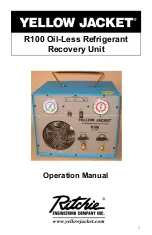
7
VAPOR & LIQUID (DIRECT) RECOVERY
Vapor or Liquid Recovery is used to pull
refrigerant directly out of the system to be
serviced. The refrigerant is then trans-
ferred to a recovery tank.
Liquid Recovery is used when connecting
to the high pressure side of the system to
be serviced or any other service port that
liquid refrigerant is present.
Either Vapor or Liquid Recovery can be
used when connecting to the low pres-
sure side or any other service port that
vapor refrigerant is present.
IMPORTANT: If you are not sure
whether liquid refrigerant is present,
choose Direct Liquid Mode. This mode
limits the amount of liquid refrigerant
entering the compressor. Recovery of
liquid refrigerant in the Vapor Recov-
ery mode can damage the compressor.
If large quantities of liquid refrigerant are
expected, use the liquid push-pull
method. Push-pull will transfer liquid
refrigerant faster than direct liquid recov-
ery.
The hose connections for vapor & liquid
recovery are shown in the figure 2. To
perform vapor or liquid recovery, please
follow the steps below:
1. Turn off power to the system to be
serviced.
2. Turn the Suction Valve to “OFF” and
the Discharge Valve to “RECOVER.”
3. Connect the recovery unit, the system
to be serviced, and the recovery tank
as shown in the figure 2. The suction
hose can be connected to the liquid
and/or vapor service ports.
If you
connect to the liquid service port,
ensure you use Liquid Recovery.
Also ensure the hose to the tank is
connected to the DISCHARGE port of
the recovery unit.
4. Open the vapor valve on the recovery
cylinder.
5. Turn the discharge valve (right) to
“RECOVER” position.
6. Turn the
System Switch
”ON”. The
Green LED should energize.
7. Turn the suction valve (left) to:
“VAPOR RECOVERY” for vapor recovery
from the vapor service
port.
“LIQUID RECOVERY” for liquid recovery
from the liquid service
port.
CAUTION: If unsure of the refriger-
ant’s phase, always choose
the “LIQUID RECOVERY”
position.
Note: If the Yellow LED energizes, the
recovery tank is full. Turn off power.
Turn off both valves. Exchange recovery
tank with an empty one. Repeat Steps 3-
6.
If the Red LED energizes, the recovery
unit is sensing a high-pressure limit. Turn
off power and check for restrictions. If
tank pressure is above 400 psig, ex-
change tank. Repeat Steps 3-6.
7. After the Suction Pressure Gauge indi-
cates the required vacuum, turn the
discharge valve to “PURGE” to remove
the remaining refrigerant from the re-
covery unit.
8. When the Suction Pressure Gauge
indicates a vacuum, Turn the SUC-
TION VALVE to “OFF”, Turn off the
power to the recovery unit, and Discon-
nect the two refrigerant hoses.
Recovery and Purge Operations are now
complete. The R100 is ready for the
next job.












